Bread Crumbs Market Size and Share
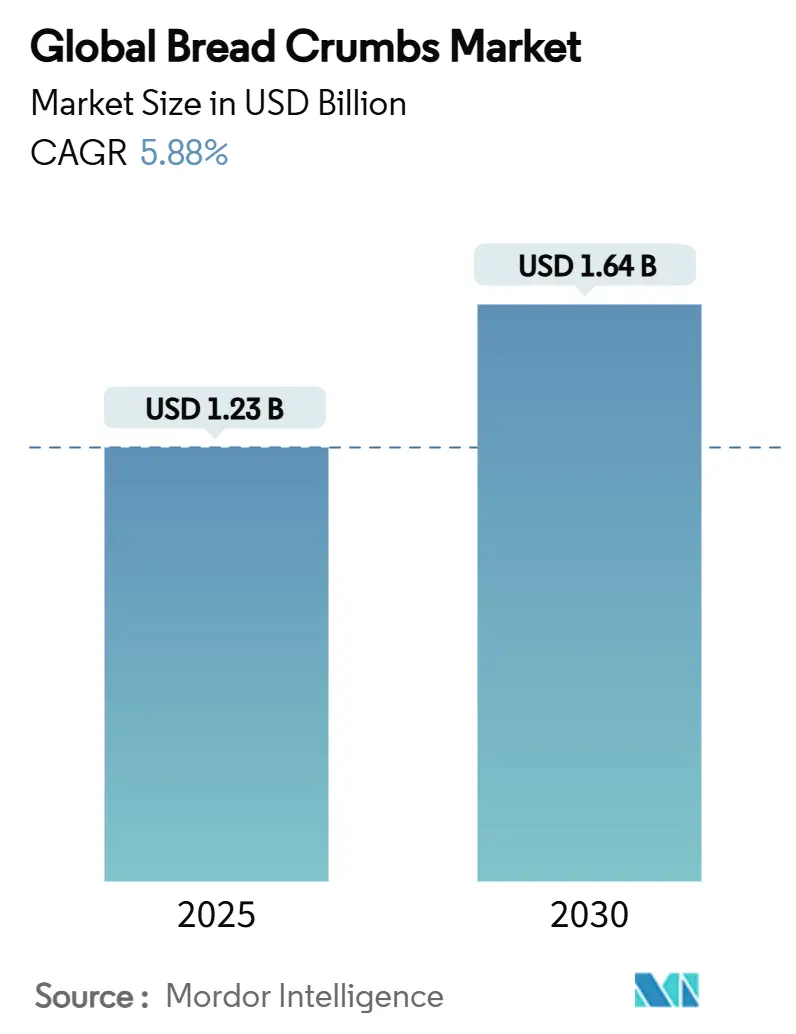
Bread Crumbs Market Analysis by Mordor Intelligence
The bread crumbs market size currently stands at USD 1.23 billion in 2025 and is expected to reach USD 1.64 billion by 2030, demonstrating a steady growth rate of 5.88% CAGR. The market is experiencing robust growth due to several factors, including the increasing consumer preference for convenience foods and the continuous expansion of quick-service restaurants worldwide. Food manufacturers are making substantial investments in texture-enhancing ingredients to develop premium product offerings that meet evolving consumer preferences. The industry is witnessing significant technological advancements, particularly in panko production automation and smart packaging solutions, which help extend product shelf life while enhancing product differentiation and profit margins. In response to growing consumer health concerns, regulatory bodies have intensified their focus on allergen disclosure requirements, compelling larger manufacturers to implement sophisticated manufacturing systems. This trend particularly benefits companies with scale operations that can consistently maintain and guarantee specific gluten thresholds. Furthermore, the European market is experiencing a transformation driven by sustainability legislation, which is encouraging manufacturers to transition toward recyclable packaging solutions. This shift has established packaging innovation as a crucial competitive advantage in the bread crumbs market.
Key Report Takeaways
- By crumb type, panko led with 46.43% bread crumbs market share in 2024 and is forecast to expand at a 6.94% CAGR through 2030.
- By ingredient, wheat-based variants retained 62.44% share in 2024, while multi-grain recorded the fastest 7.01% CAGR for 2025-2030.
- By flavor, the unflavored segment held 67.43% of the bread crumbs market size in 2024; flavored crumbs are advancing at a 7.26% CAGR to 2030.
- By distribution channel, foodservice commanded 57.38% share in 2024, whereas the retail channel is set to grow at a 6.85% CAGR through 2030.
- By geography, Asia-Pacific captured 51.38% of the bread crumbs market in 2024 and is rising at a 6.90% CAGR, outpacing every other region.
Global Bread Crumbs Market Trends and Insights
Drivers Impact Analysis
| Driver | (~) % Impact on CAGR Forecast | Geographic Relevance | Impact Timeline |
|---|---|---|---|
| Growing consumer preference for convenience foods | +1.2% | Global, led by India | Medium term (2-4 years) |
| Advancements in packaging technologies | +0.8% | North America, EU, expanding to APAC | Long term (≥ 4 years) |
| Ongoing innovation in breadcrumb production methods | +0.6% | APAC core, spill-over to MEA | Medium term (2-4 years) |
| Rising demand in bakery and snack products | +0.9% | Global, strongest in APAC | Short term (≤ 2 years) |
| Increased use of global/ethnic cuisine fusion | +0.7% | North America, Europe, urban APAC | Medium term (2-4 years) |
| Product utility for texture, binding, and flavor | +0.5% | Global | Long term (≥ 4 years) |
| Source: Mordor Intelligence | |||
Growing Consumer Preference for Convenience Foods
The convenience food revolution is reshaping breadcrumb demand patterns. This growth correlates with increased breadcrumb consumption as manufacturers use these ingredients for texture enhancement and binding in ready-to-eat meals. The expansion of frozen ready meals, particularly in North America and Western Europe, creates consistent demand for breadcrumbs as coating agents that maintain crispness during microwave preparation. Premium convenience foods require specialized breadcrumb formulations, extending beyond basic coating applications to texture engineering. The foodservice industry's e-commerce adoption, with distributors investing in technology and value-added services, increases demand through broader distribution of breadcrumb-enhanced convenience products. The combination of convenience culture and technological distribution capabilities establishes breadcrumbs as essential components in the food ecosystem.
Advancements In Packaging Technologies for Improved Shelf Life and Product Safety
Packaging innovation has emerged as a key competitive advantage in the breadcrumb market, highlighted by OSY Group securing EURO 750,000 funding in May 2024 to develop antimicrobial coatings. These coatings help protect fresh produce by removing harmful microbes from packaging surfaces. The industry has benefited from smart packaging advances, such as quality monitoring sensors and specialized atmosphere packaging that stops bacteria from growing, ensuring breadcrumbs stay fresh during transport and storage. Companies are now using plant-based packaging solutions that work on two levels - they keep products fresh and help the environment through biodegradable materials that naturally fight bacteria. Natural coatings applied directly to breadcrumbs offer a practical solution by keeping moisture in and harmful organisms out while maintaining product freshness. These advances help manufacturers stand out through better product quality rather than just price, creating opportunities for premium products with better profit margins while meeting environmental goals.
Ongoing Innovation in Bread Crumb Production Methods
Innovations in production methods are enhancing breadcrumb manufacturing efficiency and product differentiation. In panko production, specialized baking processes create crustless bread that undergoes shredding and drying to achieve specific textures. The industry's move toward automated systems is evident through Sojo Industries' USD 40 million Series B funding in June 2025 for modular packaging and automation platforms. This investment reflects manufacturers' focus on scalable technologies that reduce labor costs while maintaining product consistency. The integration of ancient grains into breadcrumb production has led to new milling techniques for amaranth, quinoa, and spelt, resulting in nutritionally enhanced variants. These production advancements allow manufacturers to develop premium products that align with consumer health preferences, elevating breadcrumbs from basic ingredients to high-value food components.
Rising Demand for Breadcrumbs in Bakery and Snack Products
The bakery and snack market continues to transform how manufacturers use breadcrumbs beyond traditional coatings. This transformation is evident in product innovations from major industry players. Bimbo Bakeries USA demonstrates this shift through its Grains Almighty product line, which combines whole grains with innovative ingredients like chickpea flour and pea protein. This evolution reflects consumers' growing focus on health and wellness, prompting manufacturers to reimagine breadcrumbs as essential binding agents in protein-enriched and fiber-enhanced baked goods. The recent industry consolidation, marked by Mars' USD 35.9 billion acquisition of Kellanova in August 2024, creates significant opportunities in the market. This strategic move opens new paths for breadcrumb suppliers to integrate into larger product portfolios, potentially collaborating with established brands such as Pringles and Cheez-It to develop innovative product applications.
Restraints Impact Analysis
| Restraint | (~) % Impact on CAGR Forecast | Geographic Relevance | Impact Timeline |
|---|---|---|---|
| Stringent food safety and labeling regulations | -0.6% | Global, with strictest enforcement in EU and North America | Long term (≥ 4 years) |
| Allergen concerns limiting consumer base | -0.8% | North America & EU primarily, expanding to APAC | Medium term (2-4 years) |
| Rising demand for low-carb or keto diets reducing usage | -0.4% | North America and Europe, limited APAC impact | Short term (≤ 2 years) |
| Environmental concerns regarding single-use or non-sustainable packaging | -0.5% | EU leading, expanding globally | Long term (≥ 4 years) |
| Source: Mordor Intelligence | |||
Stringent Food Safety and Labeling Regulations
Global regulatory requirements for breadcrumb products are undergoing significant changes that affect manufacturers of all sizes. The FDA's FSIS Directive 7,230.1 has introduced comprehensive measures requiring companies to verify "Big 9" allergen labeling for wheat-based breadcrumb products [1]Source: USDA Food Safety and Inspection Service, “FSIS Directive 7230.1,” usda.gov. This includes detailed ingredient declarations and implementation of robust cross-contamination prevention protocols. In the Canadian market, the Food Inspection Agency has established detailed labeling distinctions between "enriched bread crumbs" and "toasted wheat crumbs," which manufacturers must follow based on the characteristics of source materials [2]Source: Government of Canada, “Food Labelling Regulations for Bakery Products,” canada.ca. European manufacturers face additional challenges with EU Regulation 2025/40, which mandates the transition to recyclable packaging by 2030 and implements extended producer responsibility frameworks for all packaging producers [3]Source: European Commission, “Proposal for Packaging and Packaging Waste Regulation,” ec.europa.eu. These regulatory developments have created substantial compliance requirements that particularly impact small manufacturers' operational costs, while potentially shifting market advantage toward larger companies that have well-established quality management systems. The FDA's approach to allergen thresholds, while essential for consumer safety, requires manufacturers to implement comprehensive monitoring systems and maintain detailed documentation throughout their supply chain operations.
Allergen Concerns Limiting Consumer Base
Consumer awareness of allergens has transformed the wheat-based breadcrumb market landscape. As more people identify gluten intolerance symptoms, manufacturers must adapt to FDA guidelines requiring gluten-free products to contain less than 20 ppm of gluten. Companies operating shared facilities are investing in dedicated production lines and enhanced cleaning procedures to prevent cross-contamination between different grain types. Consumer preferences are shifting toward alternative grains, with the Whole Grains Council supporting options like chia, amaranth, and quinoa, particularly in developed markets where consumers prioritize health considerations in their purchasing decisions. While this trend presents challenges for traditional wheat-based breadcrumb products, it creates new opportunities for alternative grain products. The requirement for clear allergen labeling, while protecting consumers, has divided the market into distinct segments and could limit growth in markets where allergen awareness is high.
Segment Analysis
By Crumb Type: Panko Dominance Drives Premium Positioning
Panko breadcrumbs hold a 46.43% market share in 2024 and are projected to grow at a 6.94% CAGR through 2030. Their superior oil absorption and distinctive texture provide lighter, crispier coatings compared to traditional breadcrumbs. The growth in this segment is driven by foodservice industry expansion and increased consumer interest in Japanese cuisine. The unique manufacturing process of panko involves producing crustless bread followed by specialized shredding and drying, which creates its characteristic airy texture that enhances various culinary applications across restaurants, food manufacturers, and home cooking.
Fresh breadcrumbs maintain consistent demand in artisanal and premium food segments, especially in European markets where traditional cooking methods remain prevalent. These breadcrumbs are particularly valued in high-end restaurants and specialty food production for their ability to provide authentic textures and flavors. Dry breadcrumbs continue to dominate mass-market applications, including ready-to-eat meals and processed foods, serving as a versatile ingredient in industrial food production and commercial kitchens where consistency and longer shelf life are essential requirements.
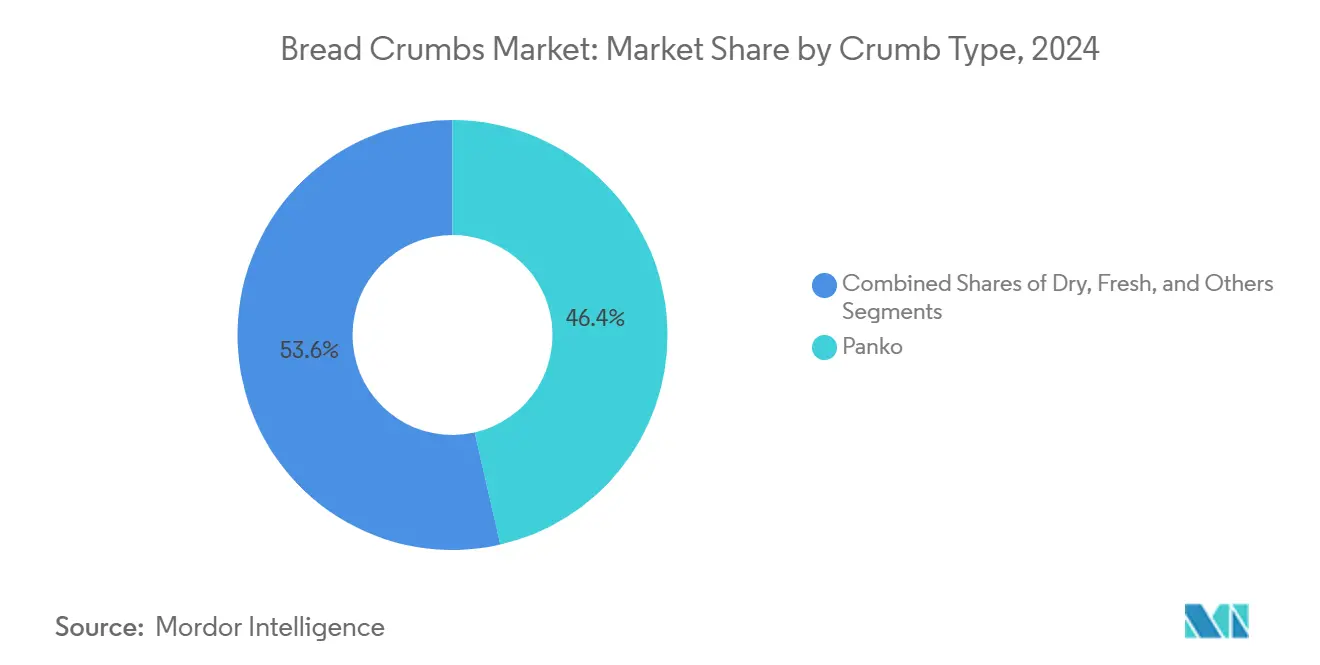
Note: Segment shares of all individual segments available upon report purchase
By Ingredient: Multi-Grain Innovation Challenges Wheat Supremacy
Multi-grain breadcrumbs are projected to grow at a CAGR of 7.01% through 2030, while wheat-based products hold a 62.44% market share in 2024. This trend reflects increasing consumer demand for nutritious alternatives in their daily diet. The shift toward healthier options has prompted manufacturers to diversify their product portfolios, with companies like Bimbo Bakeries USA incorporating diverse ingredients such as chickpea flour and pea protein into their product lines.
The Whole Grains Council's promotion of heritage grains, including amaranth, quinoa, and spelt, has encouraged consumers to explore non-wheat alternatives in their food choices [4]Source: Whole Grains Council, “Ancient Grains Consumption Trends,” wholegrainscouncil.org. This growing interest in ancient grains has created significant opportunities for manufacturers to develop innovative products that combine traditional and alternative flours, meeting the evolving preferences of health-conscious consumers while maintaining the familiar taste and texture profiles they expect.
By Flavor: Seasoned Variants Accelerate Market Premiumization
The flavored breadcrumb segment is growing at a 7.26% CAGR through 2030, while unflavored breadcrumbs hold 67.43% of the market share in 2024. The growth in flavored breadcrumbs stems from ethnic cuisine trends and consumer preference for convenient flavor solutions. Home cooks and foodservice operators increasingly use these products to create distinctive dishes without complex seasoning steps. The rise in global cuisine, especially Asian and Mediterranean influences, has increased demand for breadcrumbs with integrated herbs, spices, and regional flavors that complement various cooking applications and culinary traditions.
Unflavored breadcrumbs remain dominant in the market due to their versatility and cost-effectiveness, particularly in food manufacturing where companies control seasoning independently across product lines. These traditional breadcrumbs serve as a foundation for many food products, allowing manufacturers to maintain consistency in their production processes. The flavored segment's growth indicates consumers' willingness to pay premium prices for convenience and enhanced flavors, reflecting a broader market shift toward value-added convenience products in both retail and foodservice sectors.
By Distribution Channel: Retail Momentum Reshapes Market Dynamics
The retail channel is expected to grow at a CAGR of 6.85% through 2030, while the foodservice segment holds a 57.38% market share in 2024. This growth reflects changes in consumer behavior and increased adoption of distribution technologies. Foodservice distributors are integrating e-commerce capabilities and investing in technology and value-added services, creating additional breadcrumb distribution channels while maintaining their bulk purchasing advantages.
Supermarkets and hypermarkets remain the primary retail distribution channels due to their scale and accessibility, offering consumers a wide range of products and package sizes. Convenience stores focus on impulse purchases and smaller package sizes for individual consumers, meeting the needs of on-the-go shoppers. The online retail segment shows the highest growth rate among retail subchannels, supported by increased digital adoption during the pandemic and growing consumer preference for home-delivered cooking ingredients. This shift in consumer shopping behavior has prompted retailers to enhance their digital capabilities and delivery infrastructure.
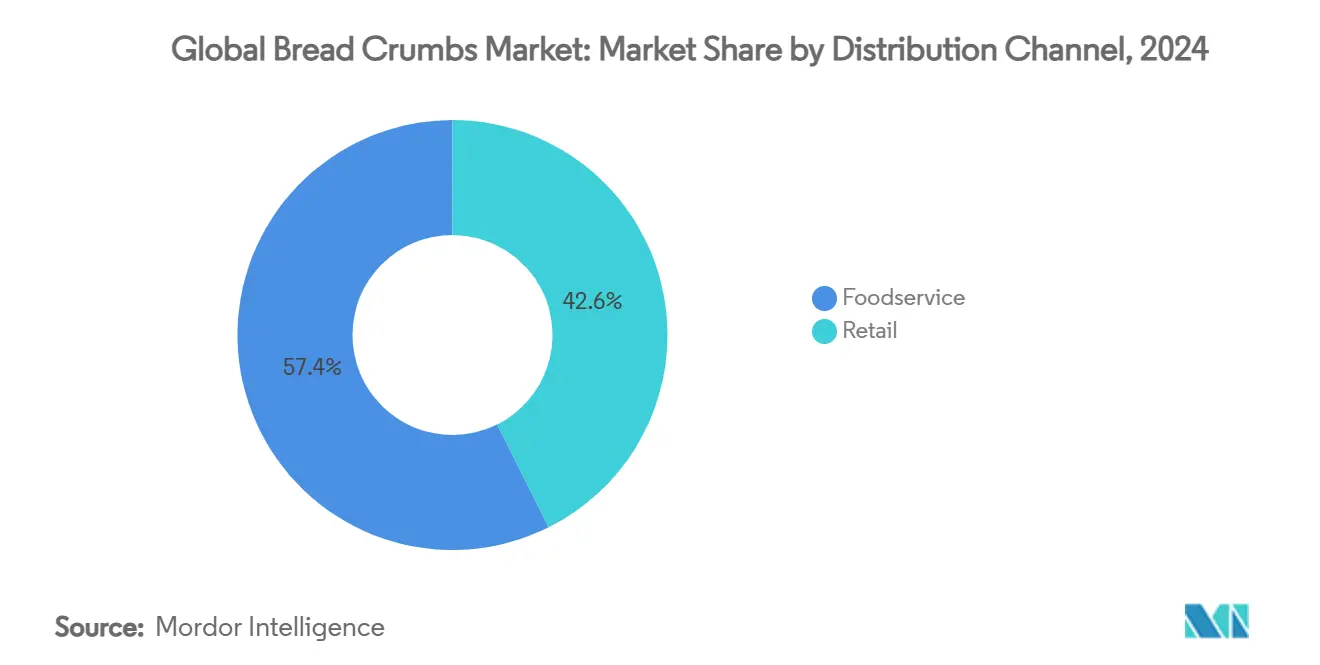
Geography Analysis
Asia-Pacific has established itself as the dominant force in the global breadcrumb market, commanding a substantial 51.38% market share in 2024. The region's strong market position is underpinned by China's thriving restaurant industry, which has witnessed remarkable revenue growth and increased adoption of breadcrumbs in both traditional and fusion cuisine. India's food processing sector continues to expand, making it a key market for breadcrumb applications in ready-to-eat meals and processed foods. Japan's market is shaped by unique dietary trends, particularly the government-driven emphasis on fiber fortification in bakery products, which has created opportunities for specialized breadcrumb formulations.
The region's impressive growth trajectory, marked by a 6.90% CAGR through 2030, reflects the transformative impact of rapid urbanization and rising disposable incomes across Asia-Pacific. This growth is further accelerated by the increasing adoption of Western food preparation methods, where breadcrumbs play a crucial role in enhancing texture and flavor profiles. The combination of economic development and evolving food consumption patterns positions Asia-Pacific as the most dynamic market for breadcrumb manufacturers and suppliers.
North America and Europe maintain mature market positions with well-established consumption patterns and stringent regulatory frameworks for food safety and allergen management. The U.S. market structure favors large-scale suppliers due to the concentrated food retail sector, while European manufacturers adapt to new sustainability requirements in packaging. In emerging regions, South America, led by Brazil's growing food processing sector, shows promising development. The Middle East benefits from its young population and expanding restaurant industry, while Africa's market potential is gradually unlocking through improved infrastructure and urbanization, particularly in Nigeria and South Africa.
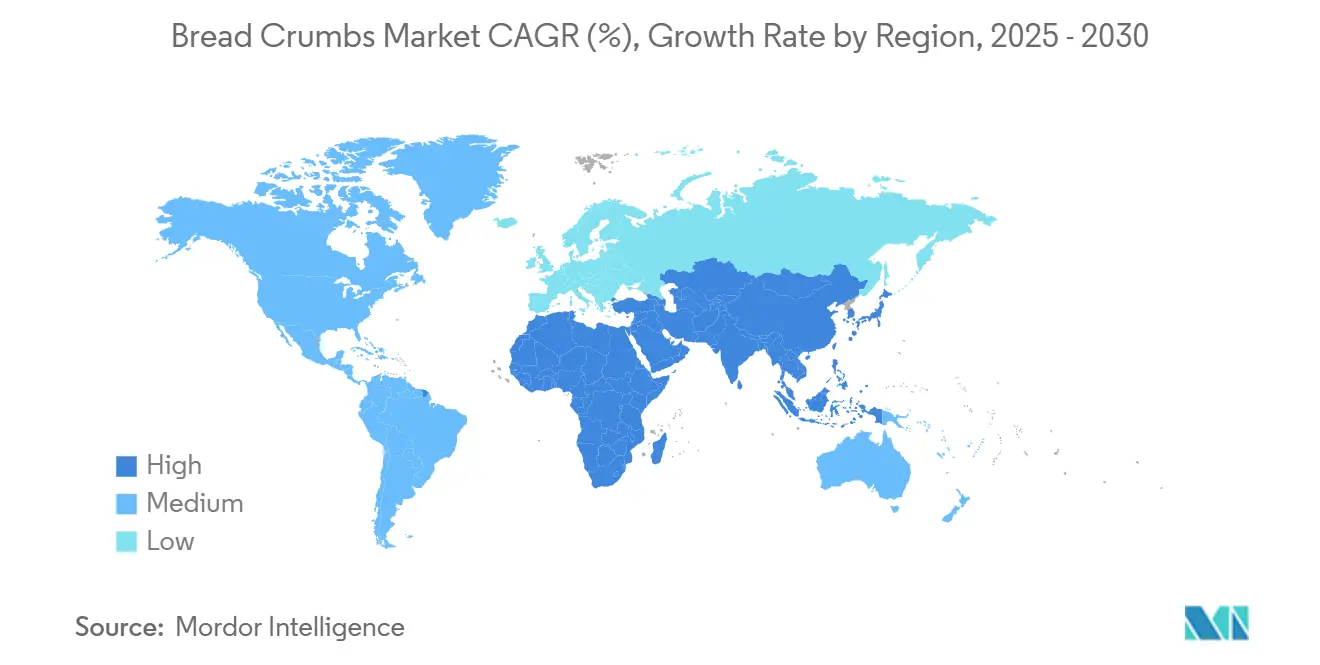
Competitive Landscape
The breadcrumb market shows moderate fragmentation, with larger players gaining market share from smaller regional manufacturers through economies of scale and distribution advantages. The industry has evolved from basic commodity competition to differentiated products focusing on texture, flavor, and specialized culinary applications. McCormick & Company exemplifies this market positioning, with its consumer segment accounting for 57% of consolidated net sales, while its flavor solutions segment serves food manufacturers and foodservice customers.
Companies are investing in automated production systems, securing funding for modular packaging and automation platforms to reduce labor costs and improve production consistency. The industry presents opportunities in sustainability and premium segments, particularly through plant-based packaging and ancient grain formulations that address environmental and health concerns.
The moderate market concentration creates acquisition opportunities for established food companies looking to integrate breadcrumb production into their portfolios. Companies are implementing smart packaging solutions for extended shelf life and freshness monitoring. Strict allergen labeling requirements and packaging sustainability regulations favor larger companies with established quality management systems, while creating entry barriers for smaller manufacturers. These factors indicate continued market consolidation as companies pursue scale advantages and invest in innovation for premium positioning.
Bread Crumbs Industry Leaders
-
Kerry Group plc
-
Newly Weds Foods Inc.
-
McCormick & Company Inc.
-
Kikkoman Corporation
-
Grupo Bimbo SAB de CV
- *Disclaimer: Major Players sorted in no particular order
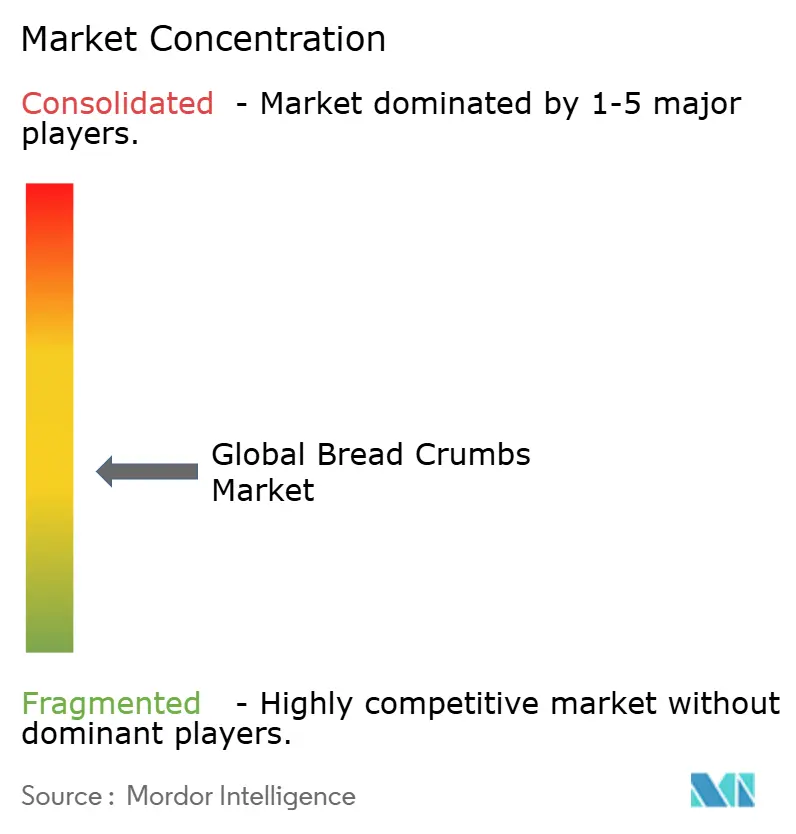
Recent Industry Developments
- January 2025: Newly Weds Foods has inaugurated a new production line. The facility spans 5,200 square meters with an 8,000-square-meter production area and reaches a height of 22 meters. The facility has storage capacity for 2,400 pallets. The upper level contains a production line for Japanese-style breadcrumbs, featuring an autobake oven for crisp bread production.
- October 2024: Aleia's Gluten Free Foods, LLC relocated to a new facility that has received certification from two gluten-free organizations: GFCO and The GFMP (Gluten Free Manufacturing Program). The facility operates under SQF and HACCP standards, with established GMP and operating procedures for cleanup and sanitation.
- September 2024: AB Kauno Grūdai, a subsidiary of AB Akola Group, has invested EUR 6.7 million in a new breadcrumb factory. The investment covers the construction and equipment of the facility.
Global Bread Crumbs Market Report Scope
| Dry |
| Fresh |
| Panko |
| Others |
| Wheat-Based |
| Corn-Based |
| Rice-Based |
| Multi-Grain |
| Others |
| Unflavored |
| Flavored |
| Foodservice | |
| Retail | Supermarkets and Hypermarkets |
| Convenience Stores | |
| Online Retail | |
| Others |
| North America | United States |
| Canada | |
| Mexico | |
| Rest of North America | |
| Europe | Germany |
| United Kingdom | |
| Italy | |
| France | |
| Spain | |
| Netherlands | |
| Poland | |
| Belgium | |
| Sweden | |
| Rest of Europe | |
| Asia-Pacific | China |
| India | |
| Japan | |
| Australia | |
| Indonesia | |
| South Korea | |
| Thailand | |
| Singapore | |
| Rest of Asia-Pacific | |
| South America | Brazil |
| Argentina | |
| Colombia | |
| Chile | |
| Peru | |
| Rest of South America | |
| Middle East and Africa | South Africa |
| Saudi Arabia | |
| United Arab Emirates | |
| Nigeria | |
| Egypt | |
| Morocco | |
| Turkey | |
| Rest of Middle East and Africa |
| By Crumb Type | Dry | |
| Fresh | ||
| Panko | ||
| Others | ||
| By Ingredient | Wheat-Based | |
| Corn-Based | ||
| Rice-Based | ||
| Multi-Grain | ||
| Others | ||
| By Flavor | Unflavored | |
| Flavored | ||
| By Distribution Channel | Foodservice | |
| Retail | Supermarkets and Hypermarkets | |
| Convenience Stores | ||
| Online Retail | ||
| Others | ||
| By Geography | North America | United States |
| Canada | ||
| Mexico | ||
| Rest of North America | ||
| Europe | Germany | |
| United Kingdom | ||
| Italy | ||
| France | ||
| Spain | ||
| Netherlands | ||
| Poland | ||
| Belgium | ||
| Sweden | ||
| Rest of Europe | ||
| Asia-Pacific | China | |
| India | ||
| Japan | ||
| Australia | ||
| Indonesia | ||
| South Korea | ||
| Thailand | ||
| Singapore | ||
| Rest of Asia-Pacific | ||
| South America | Brazil | |
| Argentina | ||
| Colombia | ||
| Chile | ||
| Peru | ||
| Rest of South America | ||
| Middle East and Africa | South Africa | |
| Saudi Arabia | ||
| United Arab Emirates | ||
| Nigeria | ||
| Egypt | ||
| Morocco | ||
| Turkey | ||
| Rest of Middle East and Africa | ||
Key Questions Answered in the Report
How large is the bread crumbs market in 2025?
The bread crumbs market size is USD 1.23 billion in 2025, with a 5.88% CAGR projected to 2030.
Which region leads the bread crumbs market?
Asia-Pacific holds 51.38% share and is set to grow at a 6.90% CAGR through 2030, driven by expanding restaurant and food-processing industries.
Why is panko gaining popularity over traditional crumbs?
Panko’s crust-free structure delivers lighter, crunchier coatings with lower oil uptake, securing 46.43% market share in 2024 and the fastest 6.94% CAGR.
What is driving the surge in flavored breadcrumbs?
Ethnic cuisine fusion and consumer demand for quick flavor solutions push flavored variants to a 7.26% CAGR, outpacing the unflavored segment.
How are regulations shaping manufacturing strategies?
Mandatory allergen disclosures, gluten thresholds, and recyclable packing rules are raising compliance costs, favoring larger companies with robust traceability and packaging R&D.
Page last updated on:



